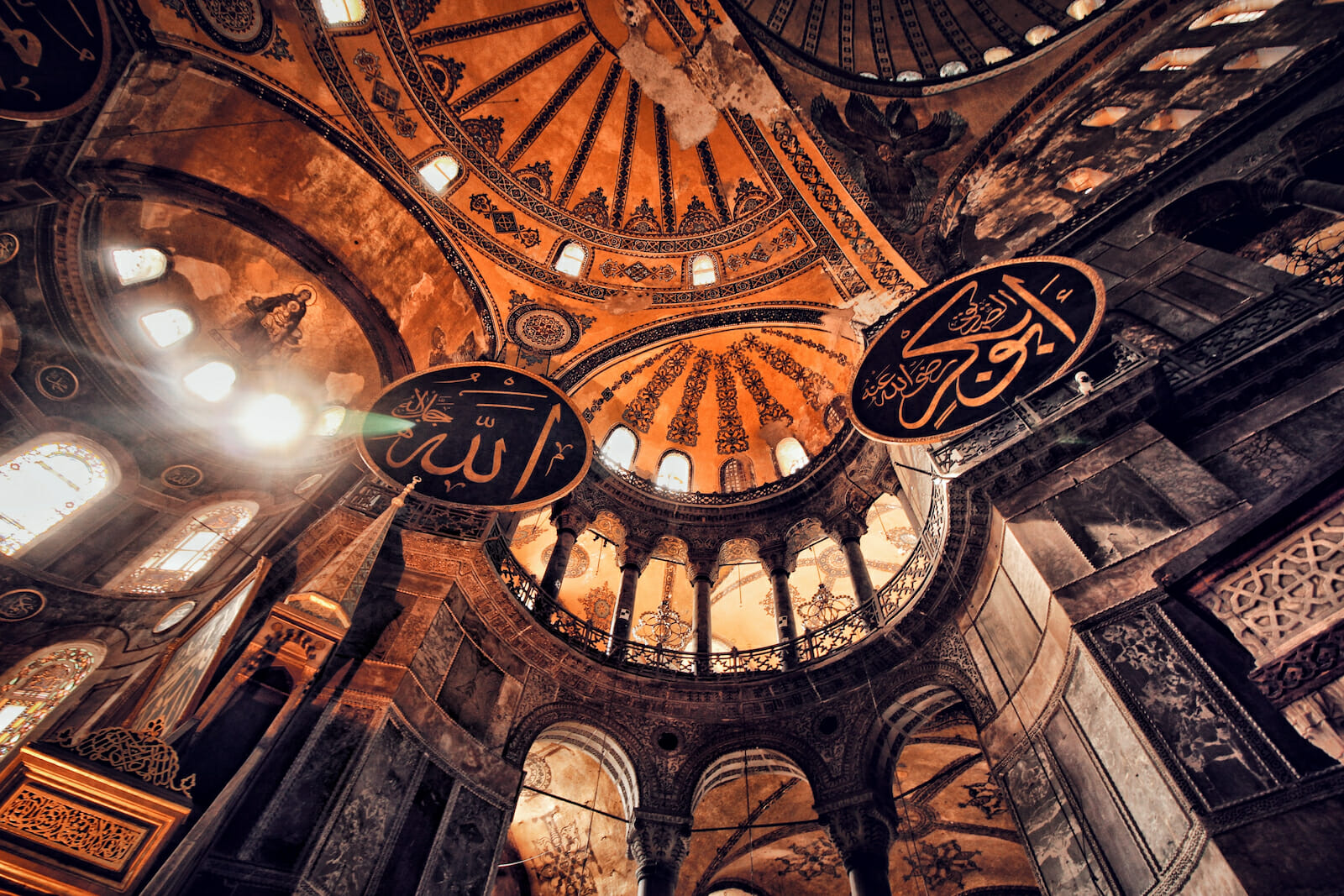
Culture
Recep Tayyip Erdogan’s Use of Symbols in Reclaiming the Hagia Sophia as an Imperial Mosque
Turkish President Recep Tayyip Erdogan has demonstrated his penchant for drama and symbols. At a state reception on 12 January 2015 for President Mahmoud Abbas of the Palestinian Authority, Erdogan had soldiers dressed in the purported military attire of 16 Turkic states from the past. Three days later, the same performance was arranged to greet President Ilham Aliyev of Azerbaijan. The reconversion of Istanbul’s Hagia Sophia Museum (Ayasofya Müzesi) into a mosque and the celebration of the Friday service on 24 July 2020 bore the same strokes of the calculated use of drama and symbols for a political purpose. In this case, Erdogan’s orchestration was directed at two audiences: Europe and the United States, and Turkey and foreign Muslim communities. For the former, it was calculated provocation and defiance in the response to the reaction that it was designed to provoke. For the latter, it was an opportunity to show independence and leadership to a domestic constituency that Erdogan seeks to mobilize and a foreign constituency that he wishes to court. Erdogan staged the event to realize both ends.
Erdogan has guided much of his policy vis-à-vis Europe by the Turkish adage “The dog barks; the caravan goes on.” Erdogan’s sabotage of Turkey’s candidacy for membership in the European Union through acts to provoke the European Union, and especially Greece, makes him appear stronger to himself and to his perceived Turkish constituency. In the case of Hagia Sophia, Erdogan picked a high profile edifice known to the casual tourist and the scholar alike, one with great artistic and historical value, and great religious meaning amongst Orthodox Christians, hence a special provocation of Greece, Russia, the Orthodox-majority states. When Justinian I completed in 562 the construction of the Church of Hagia Sophia, the Church of the Divine Wisdom, a considered attribute of Christ, he was reported to have said “I have surpassed thee, Solomon.”
The Hagia Sophia from that time remained the world’s largest cathedral until 1453 when the Ottoman Empire took Constantinople and converted the cathedral into a mosque, the Grand Mosque of Ayasofya (Ayasofya-i Kebir Cami-i Şerifi). At that time, the cathedral had great displays of mosaics, which were not destroyed, but whitewashed, as part of the building’s conversion into a mosque. Although as a mosque, later as a museum, and now as a mosque, the Hagia Sophia has retained its great importance amongst Orthodox Christians worldwide for over five centuries. Under the republican government of Mustafa Kemal Atatürk, the whitewash was removed and the mosaics were renovated. In 1934 the building was declared a museum and remained so until July 2020. As a means to show that he would be a zealous curator of the building’s historic value, Erdogan made a point of saying that the mosque would be like the Cathedral of Notre Dame in Paris, a functioning house of worship, but open to visitors to appreciate its art treasures. Hence, the mosaics of Byzantine art would be covered with cloth during times of prayer, but the coverings would be raised and remain raised at other times. Erdogan’s lengthy public campaign to convert the museum into a mosque and the celebration of Friday services provoked the reaction that he had sought. Erdogan met the international protests with his characteristic display of defiance in the defence of Turkish sovereignty in having restored the structure, after a hiatus of 86 years, as a mosque of over half a millennium. The details in the planning of the event, even the selection of the date, 24 July, had been made with great thought to make a deeper impression on a Turkish audience and a Muslim constituency abroad.
24 July is the anniversary of the Treaty of Lausanne of 1923, which is considered to be one of the founding documents of the Republic of Turkey. This treaty became the basis for the international recognition of the Republic of Turkey, and Mustafa Kemal Atatürk’s and the republican movement’s determination to break with the Ottoman multiethnic Islamic past, to establish in its stead a secular nation-state, and to confine religion to the private sphere. On the same day that Erdogan had Friday services celebrated at the newly reclaimed mosque, the Anıtkabir in Ankara, Atatürk’s mausoleum, was closed for disinfection. The timing of both events was planned to make clear Erdogan’s contempt for republican secular institutions, which had eliminated the sultanate in 1922 and the caliphate in 1924, the latter having been an assertion of the empire’s leadership of world Islam. For Erdogan, this was a message for both domestic and foreign consumption. The same care was made for the day’s events.
As he delivered the sermon, Erbaş held a sheathed sword-bearing three moon crescents representing the three continents under Ottoman rule. Erbaş asserted the right to hold the sword, as the Ayasofya had been taken by conquest. According to Hakkı Aksoyak in his article “Hutbeyi Kılıçla Okumak” (Reading the Hutbe with Sword), this tradition has early Islamic roots as it has been reported that the Prophet Muhammad would deliver the Friday sermon with a scepter or an archer’s bow in hand. Later, to hold a sword while delivering the Friday sermon became a means to show that a particular mosque had become one as the result of conquest.
In his sermon, Erbaş placed the day’s event in the context of the battles of Badr, Manzikert, Çanakkale, and Sakarya, and 15 July, all recognizable events to his public: the Battle of Badr, when Muhammad and his forces defeated the Qureysh in 624; the Battle of Manzikert, the Seljuk Turks’ victory in 1071 against Constantinople’s forces, which opened Anatolia to conquest; Çanakkale, which marks the defeat of the Allies in the Gallipoli Campaign in World War I; Sakarya, where the Turkish forces stopped the Greek offensive in 1921 during the Turkish War of Independence; and 15 July is a reference to the failed coup d’état against Erdogan in 2016. Similarly, Erbaş made reference to the aforementioned Sultan Mehmet II, who had realized, at that time, the eight-hundred-year-old Islamic imperative to capture Constantinople and had converted the Church of Hagia Sophia into an imperial mosque. In an effort to establish leadership beyond Turkey, Erbaş stated that the restoration of the Ayasofya was an event not for Turkey alone, but for all oppressed mosques, especially the Al-Aksa Mosque in Jerusalem. Erdogan, on the same theme as a part of the service, chanted the Surah of Conquest (Al-Fath Surah). Verse 25 begins “Those were the unbelievers who debarred you from the Sacred Mosque and prevented your offerings from reaching their destination,” a clear reference to Atatürk and his government of the People’s Republic Party (Cumhurriyet Halk Partisi), which had closed the Ayasofya and had converted it into a museum, and subsequent government and state officials for having maintained it as so. The theme of conquest continued after the services had ended.
Erdogan and a retinue of government officials, accompanied by members of the mass media, went to pay their respects at the tomb of Sultan Mehmet II, in the complex of the Mosque of Mehmet the Conqueror (Fatih Camii). This day had been planned by Erdogan to show that he was correcting the deviation from the natural line of Turkish and Islamic history of over 1,300 years. For centuries, the Ottoman Empire had ruled on three continents, well beyond the border of today’s Republic of Turkey. Erdogan’s reconversion of the Ayasofya into a mosque was a move to seek the support of Muslims in the world community, especially those living today in countries that had been under Ottoman rule, as well as to strengthen support from sectors of the Turkish population who had felt alienated by republican rule.
Erdogan’s sartorial display to Mahmoud Abbas and to Ilham Aliyev was a demonstration of to whom fealty was due: from Aliyev, as Erdogan was presenting himself as the leader of the dominant Turkic state of Turkey, and from Abbas, as Erdogan was presenting himself as the inheritor of the Ottoman Empire, which had ruled four of the past five centuries over Abbas’s territory. So too has Recep Tayyip Erdogan presented himself as having put right the republican deviation from Sultan Mehmet II’s conquest of Constantinople in 1453.
